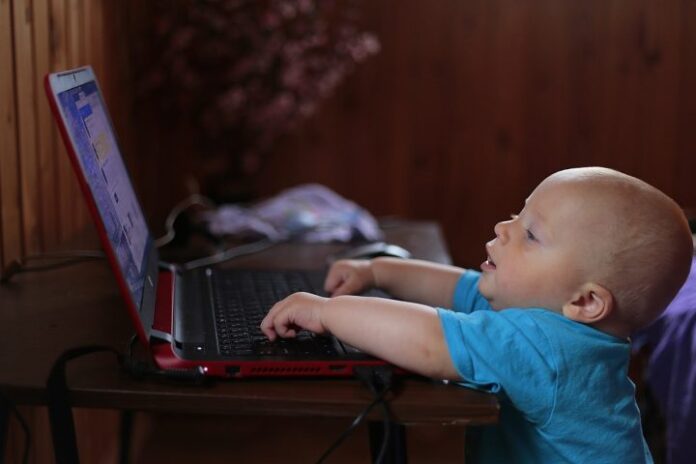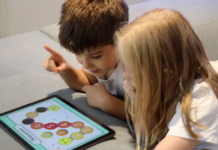Published in the Harvard Kennedy School’s Shorenstein Center and the Carnegie-Knight Initiative, Journalist’s Resource.
May 14, 2019
This research roundup, originally published in May 2019, has been updated to include a recent systematic review and meta-analysis looking at the effects of screen time on academic performance.
Gone are visions of idyllic childhoods spent frolicking in fields and playing in pastures; for many kids, green grass has been replaced with smartphone screens.
In fact, recent research finds that 63% of kids in the U.S. spend over two hours a day on recreational screen time.
This is in spite of official guidelines from the American Academy of Pediatrics, which recommends less than one hour per day of screen time for children between the ages of 2 and 5, and, for older children, “consistent limits” on screen time and prioritization of sleep, physical activity and other healthy behaviors over media use. Just last month the World Health Organization issued guidelines on the subject, stressing that children between the ages of 2 and 4 should have no more than one hour of screen time per day.
The ubiquity of screens and their prominence in everyday life has drawn criticism and concerns, with Microsoft veteran and philanthropist Melinda Gates writing about not being “prepared for smartphones and social media” as a parent and news headlines questioning whether smartphones have “destroyed a generation.”
But what does the research say? This roundup looks at the effects of screen time on children’s health. Studies range from childhood to adolescence and focus on topics including sleep, developmental progress, depression and successful interventions to reduce screen time.
Screen-Time is Associated with Inattention Problems in Preschoolers: Results from the CHILD Birth Cohort Study
Tamana, Sukhpreet K.; et al. PLOS ONE, April 2019.
This study analyzes parent-reported data about screen time and behavioral issues such as inattention and aggressiveness for a sample of 2,322 Canadian preschool-age children. Researchers found that over 13% of kids in the sample were exposed to over two hours of screen time each day including watching TV and DVDs, playing video games or using a computer, tablet or mobile device. The effects: Kids who were exposed to more screen time “showed significantly increased behavior problems at five-years,” the authors write. “Briefly, children who watched more than 2 hours of screen time/day had increased externalizing [e.g., attention and behavior], internalizing [e.g., anxiety and depression], and total behavior problems scores compared to children who watched less than 20 minutes.” Attention problems in particular were apparent in children who had over two hours of screen time each day.
Mobile Media Device Use is Associated with Expressive Language Delay in 18-Month-Old Children
van den Heuvel, Meta; et al. Journal of Developmental & Behavioral Pediatrics, 2019.
Toddlers who use mobile devices daily are more likely to experience speech delays, according to an analysis of parent-reported data on 893 children in the greater Toronto area of Canada. While 78% of parents said their kids spent no time on mobile devices, the other 22% reported a range of 1.4 to 300 minutes daily, with a median of 15.7 minutes.
In total, 6.6% of parents reported expressive speech delays (i.e., late to begin talking). The prevalence of other communication delays, such as lack of use of gestures and eye gaze, was 8.8%. The researchers found a positive association between mobile device use and expressive speech delays. “An increase in 30 minutes per day in mobile media device use was associated with a 2.3 times increased risk of parent-reported expressive speech delay,” the authors write. Other communication delays were not linked to device use. The researchers suggest the connection between device use and expressive speech delays might be explained by the fact that past research has shown infants “have difficulty applying what they learn across different contexts.” An alternate explanation is that these children who spend more time with devices might have less exposure to speech from caregivers.
Association Between Screen Time and Children’s Performance on a Developmental Screening Test
Madigan, Sheri; et al. JAMA Pediatrics, March 2019.
Is screen time detrimental to child development? This study looks at data collected from 2,441 mothers and children in Canada at three different time points – when the children were 2, 3 and 5 years old. The researchers were interested in the total number of hours the children spent looking at screens each week as well as their progress in various developmental areas such as fine motor skills, communication and problem solving. The average amount of screen time for the age groups in the study: 17, 25 and 11 hours of television per week for 2-, 3-, and 5-year olds, respectively.
The researchers found that kids who spent more time watching screens at ages 2 and 3 did worse on developmental tests at the subsequent time points of 3 and 5 years. “To our knowledge, the present study is the first to provide evidence of a directional association between screen time and poor performance on development screening tests among very young children,” the authors write.
The researchers suggest that excessive screen time leads to developmental delays, rather than the other way around – negating the notion that children with developmental delays might receive more screen time to manage their behavior.
The three phase data capture supports this explanation because children with greater screen time at one time point go on at the next time point to have poorer developmental progress, but children with poor developmental performance at an earlier time point do not receive increased screen time at later time points.
Association Between Screen Media Use and Academic Performance Among Children and Adolescents
Adelantado-Renau, Mireia; et al. JAMA Pediatrics, September 2019.
This publication consists of both a systematic review and meta-analysis of research on the relationship between screen time and academic performance. The authors identified 58 studies to include in the systematic review, which provides a summary of the qualitative effects of screen time; 30 of these studies were included in the subsequent meta-analysis, which the authors used to calculate the effect size of screen time on academic performance.
The 58 studies in the systematic review included 480,479 participants ranging from four to 18 years of age. The articles were published between 1958 and 2018 and represent the efforts of researchers around the world. The studies looked at computer, internet, mobile phone, television and video game use individually, as well as overall screen time. Outcomes of interest included school grades, performance on academic achievement tests, academic failure data, or self-reported academic achievement or school performance.
The key finding from the systematic review was that in most of the papers reviewed, as time spent watching television increased, academic performance suffered. Relationships were less clear-cut for other types of screen use.
The meta-analysis, which focused on a subset of 106,653 participants from the larger sample, did not find an association between overall screen time and academic performance. When the authors analyzed the data by type of activity, they found television watching was linked to poorer overall academic performance as well as poorer language and mathematics performance, separately. Time spent playing video games was negatively linked with composite academic performance scores, too. Analyzing the data further by age, the authors found that time spent with screens had a larger negative association with academic performance for adolescents than children.
“The findings from this systematic review and meta-analysis suggest that each screen-based activity should be analyzed individually because of its specific association with academic performance,” the authors conclude. “This study highlights the need for further research into the association of internet, computer, and mobile phone use with academic performance in children and adolescents. These associations seem to be complex and may be moderated and/or mediated by potential factors, such as purpose, content, and context of screen media use.”
The authors suggest that educators and health professionals should focus screen time reduction efforts on television and video games for their negative connections to academic performance and potential health risks due to their sedentary nature.
Screen Time Is Associated with Adiposity and Insulin Resistance in Children
Nightingale, Claire M.; et al. Archives of Disease in Childhood, July 2017.
This study looks at the relationship between screen time and Type 2 diabetes risk factors, like being severely overweight, among 4,495 schoolchildren in the United Kingdom between the ages of 9 and 10. The short of it: Kids who spent over three hours daily on screen time were less lean and more likely to show signs of insulin resistance, which can contribute to the development of Type 2 diabetes, compared with their peers who reported one hour or less of screen time each day. Black children were more likely to spend over three hours daily on devices compared with their white and south Asian peers – 23% of black children fell into that group, compared with 16% of white children and 16% of south Asian children.
Digital Media and Sleep in Childhood and Adolescence
LeBourgeois, Monique K.; et al. Pediatrics, November 2017.
This report summarizes 67 studies looking at associations between screen time and sleep health – adequate sleep length and quality — in children and adolescents. The main takeaways: A majority (90%) of the studies included in a systematic review of research on screen time in children and teenagers found adverse associations between screen time and sleep health – primarily because of later bedtimes and less time spent sleeping. Delving deeper, underlying mechanisms include “time displacement” (think scrolling Instagram for an hour that might otherwise be spent sleeping), psychological stimulation from content consumed and impacts of screen light on sleep patterns. The upshot? These kids are tired. The previously cited research review also indicates that a majority of studies saw a relationship between tiredness and screen time.
Prevalence and Likelihood of Meeting Sleep, Physical Activity, and Screen-Time Guidelines Among US Youth
Knell, Gregory; et al. JAMA Pediatrics, April 2019.
This study analyzes data from the 2011, 2013, 2015 and 2017 cycles of a nationally-administered, school-based survey on various health-related behaviors related to the leading causes of death and disability in the U.S. The researchers were interested in whether respondents met the recommendations for time spent on sleep, physical activity and screen time in a given day. A total of 59,397 adolescents were included in the data set.
The findings indicate that only 5% of adolescents surveyed met all three guidelines – that is, getting the recommended amount of sleep and physical activity and limiting screen time to less than two hours per day. There were disparities among the sample in terms of the odds of meeting all of the recommendations: 16- and 17-year-olds were less likely than those aged 14 and younger to meet all the guidelines; black, Hispanic/Latino and Asian participants were less likely to meet the three guidelines than white participants; overweight and obese participants were less likely to meet the guidelines than normal weight participants; participants who reported marijuana use were less likely to meet the guidelines than those who did not. Participants who reported depressive symptoms were also less likely to meet all the guidelines.
Associations Between 24 Hour Movement Behaviors and Global Cognition in US Children: A Cross-Sectional Observational Study
Walsh, Jeremy J.; et al. The Lancet Child & Adolescent Health, November 2018.
This study looks at the same three outcomes examined above, but adds another component – “global cognition.” This is an overall cognition score assessed by the National Institutes of Health Toolbox – an iPad-based neuro-behavioral screening tool. The assessment measures various cognitive functions including memory, attention, vocabulary and processing speed. The sample included 4,520 participants between the ages of 8 and 11. Only 5% of participants met all three recommendations – and they were the better for it. “Compared with meeting none of the recommendations, associations with superior global cognition were found in participants who met all three recommendations, the screen time recommendation only, and both the screen time and the sleep recommendations,” the authors write.
Increases in Depressive Symptoms, Suicide-Related Outcomes, and Suicide Rates Among U.S. Adolescents After 2010 and Links to Increased New Media Screen Time
Twenge, Jean M.; et al. Clinical Psychological Science, January 2018.
This study looks at the relationship between screen time and depression and suicide rates in 506,820 adolescents in the U.S. between 2010 and 2015. The data on screen time use and mental health issues came from two nationally representative surveys of students in grades 8 through 12. Suicide rates were calculated from national statistics collected by the Centers for Disease Control and Prevention’s Fatal Injury Reports.
The analysis finds a “clear pattern linking screen activities with higher levels of depressive symptoms/suicide-related outcomes [suicidal ideation — that is, thinking about suicide — and attempts] and nonscreen activities with lower levels.” Among participants who used devices for over five hours each day, nearly half – 48% — reported at least one suicide-related outcome. In comparison, 29% of those who used devices for just an hour per day had at least one suicide-related outcome.
Overall, during the time studied, suicide rates, depressive symptoms and suicide-related outcomes increased. Girls accounted for most of the rise – they were more likely to experience depressive symptoms and suicide-related outcomes than boys; they also experienced stronger effects of screen time on mental health. In particular, girls, but not boys, had a significant correlation between social media use and depressive symptoms.
Interventions Designed to Reduce Sedentary Behaviors in Young People: A Review of Reviews
Biddle, Stuart J.H.; Petrolini, Irene; Pearson, Natalie. British Journal of Sports Medicine, 2014.
This review looks at 10 systematic reviews and meta-analyses of research on interventions to reduce sedentary behaviors such as screen time among children and adolescents. The authors found that all of the included reviews determined “some level of effectiveness in reducing time spent in sedentary behavior.” Effects, however, were small. Interventions tended to be more successful among children younger than 6 years old. Strategies that were effective included restricting access to television through TV monitors, systems that use TV as a reward for physical activity and behavioral interventions such as setting goals and developing schedules for screen time.
Source: https://journalistsresource.org/studies/society/public-health/screen-time-children-health-research/
Comment:
This article addresses the effect of screen time on children Pre K – 12th grade. It cites various sources and illustrates the issue from many angles. It provides many sub-problems that could serve as jumping-off points, including academic performance, expressive language delay, physical health regarding weight and insulin resistance, sleep health, and mental health. This article also illustrates a few examples of attempted solutions, including television restrictions, setting goals, etc.




